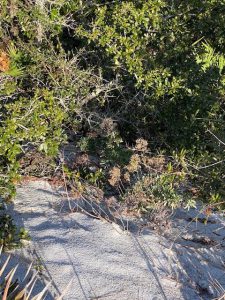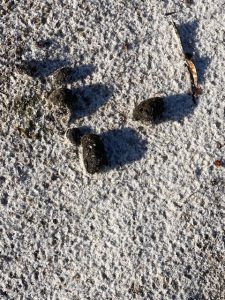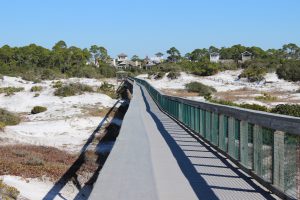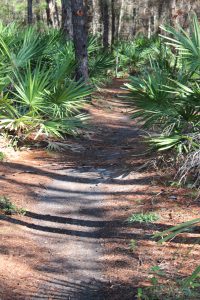
by Rick O'Connor | Feb 10, 2022
It is now mid-winter and much colder than our trip in January. During February’s hike the temperature was 44°F, compared to 62°F in January. It was overcast with a cold breeze from the northeast – again, colder. When conditions are like this I am not expecting to see much. If I did find something I would expect it to be one of our warm blood friends, mammals or birds, and even they would prefer a day with more sun and less breeze. But I came to see what was out roaming. So, a hike I made.

The Gulf front at Park East near Big Sabine.
This month I hiked the Big Sabine area east of Pensacola Beach. It began with a shore walk along the Gulf and then a transect across the different dune fields to the marshes and seagrasses along the Santa Rosa Sound.
There was no one out today. You could see footprints in the sand, and it had that characteristic “squeak” sound of fresh sand or snow. The only wildlife I saw on the Gulf side was a group of pelicans sitting on very calm water, obviously enjoying the morning. However, you could see footprints of mammals that had come earlier. There are raccoons, armadillos, mice, coyotes, and occasional reports of otters on Santa Rosa Island. There were a lot of skunks on the island prior to Hurricane Ivan (2004), but I have not seen any since. There have been reports of bears on the island as well. I have never seen one, nor their tracks, so do not think they are frequent visitors. I did find a dead shark tossed up on the beach by a fisherman. Not sure if they were trying to catch it or not.

A variety of mammals are found on barrier islands. Most move at night and you know they are there only by their tracks.

This small shark was found on the beach during the hike. I am not sure why they did not return it to the Gulf.
As I began my transect across the island I ventured into the secondary dune field, which during summer is extremely hot. This part of the island reminds me somewhat of a desert. Very dry, open, and at times very hot. Like the desert it comes alive more at night, but during winter you might see animal movement during the warm parts of the day. I did see mammalian tracks, which included humans and dogs.
This dune field also holds ephemeral ponds which can harbor a variety of life during the warmer months. Today I only found one blooming yellow-bladder wort as well as other carnivorous plants along the bank such as sundews and ground pines.

Yellow bladder wort is one of the small carnivorous plants that live on our barrier islands.

Sundews are another one of the small carnivorous plants found here.
From the open dune field, you venture into the tertiary dunes and the maritime forest. Trees grow here but their growth is stunted due to the salt content in the air. None the less, pine and oak hammocks liter this dune area providing great hiding places for wildlife. Though we did not see any today, I am expecting to find some as the weather warms.
The backside of the island is where you will find the salt marsh. This brackish wetland harbors its own community of creatures, which were not visible today but will be in the spring. Between the tertiary dunes and the marsh runs a section of the Florida Trail. Hikers can walk this section and observe wildlife from both ecosystems.

The larger dunes of the tertiary dune field.

Tree hammocks are common in the tertiary dune fields and provide good places for wildlife.
I eventually reached the Sound and the seagrass beds that exist there. Today, here was nothing really moving around, though I did find a dead jellyfish drifting in the waves. As the island wildlife tends to hideout the winter in burrows, the fish move to deeper water where it is warmer.

The backside of these large dunes drop quickly back to sea level.

Many plants in the tertiary dunes exhibit “wind sculpting”. It appears someone has taken a brush and “brushed” the tree towards the Sound.

Scat is another sign used to identify mammal activity in the dunes.

Portions of the Florida Trail cut through the tertiary dune field of Big Sabine.

The salt marsh

This holding pond is a remnant of an old fish hatchery from the late 1950s and is primarily freshwater.

Seagrass meadows can be found in Santa Rosa Sound and harbor a variety of marine life.

Jellyfish are common on both sides of the island. This one has washed ashore on Santa Rosa Sound.
There was little out today other than a few birds. We will see what late winter will expose next month.

by Rick O'Connor | Jan 6, 2022
During 2022 I plan to make weekly hikes on Pensacola Beach to see what sort of wildlife, or other natural phenomena, I encounter each month. For the first January trip I did a short hike at Ft. Pickens on the west end of Santa Rosa Island.
Ft. Pickens is more wooded than much of the island and provides both maritime forest and beach habitats for a variety of wildlife. On my first trip – Jan 6 – the temperature was 62°F and overcast. It actually rained some during the hike. As I approached the fort area, I saw a bald eagle sitting on a sand dune.

A bald eagle sitting on a dune near Pensacola Beach.
Photo: Rick O’Connor
Everyone gets excited about seeing a bald eagle. Its like dolphins, no matter how many times you see them, it is still cool, and you alert everyone they are there. The difference with bald eagles is that they were not always here. Growing up in Pensacola I rarely saw one. I worked for a period of time on what were called “the ponds” on the property of Air Products in Pace, Florida. The ponds were a water treatment system to help improve water quality coming from the plant being discharged into Escambia Bay. It was a wildlife sanctuary and there was plenty of wildlife there. Cottonmouths, deer, turtles, raccoons, and alligators were all common. One of the largest eastern diamondback rattlesnakes I have ever seen was found there. And, during the winter months, we would occasionally get a bald eagle. It was rare and very exciting.
A field guide of Birds of the Eastern United States published by Roger Tory Peterson in 1980 indicates that their winter breeding range includes much of Florida. A document published by the U.S. Fish and Wildlife suggest they begin building nests in our area in September, lay eggs by October, and hatching occurs in November. Between November and March, the parents take care of them until the fledge and head out on their own. The reason we have not seen more in our younger years was their population was down. The decline of the national bird was due to a variety of reasons, but the DDT story played a role.
Today their numbers have rebounded and encounters with them in our area have increased. Their nest can be quite large and are usually close to a water source. These birds are known as predators but actually spend a lot of time feeding on carrion and robbing other birds of their food source. Competition between the osprey, another recovering species, and bald eagles are quite famous. And, like I said, you never get tired of seeing them. This time of year, you can spot them in several locations around the beach areas.
Other creatures found on this January hike at Ft. Pickens included:

Great blue herons use tall pines for nesting during winter.
Photo: Rick O’Connor

Mockingbirds are quite common in the winter. This one was feeding on the red berries of a yaupon holly.
Photo: Rick O’Connor

This green blob is actually a sea slug known as a sea hare. It was returned to the water.
Photo: Rick O’Connor

This structure is often found on panhandle beaches. It is the egg case of the snail known as the moon snail. Also called the “shark’s eye” or “cat’s eye”.
Photo: Rick O’Connor

Unfortunately dead seabirds on the beach are not uncommon. This one is a pelican.
Photo: Rick O’Connor
I encourage to take some time this winter and go for a hike and see what you can discover.

by Rick O'Connor | Jan 8, 2021
It’s winter…
The sky is clear, the humidity is low, the bugs are gone, and the highs are in the 60s – most days. These are perfect days to get outside and enjoy. But the water is cold and you do not want to get wet – most days. And with COVID hanging around we do not want to go where there are crowds. Where can I go to enjoy this great weather, the outdoors, but stay safe?

As the summer heat fades, the weather is great for hiking! Photo credit: Abbie Seales
Hiking…
My wife and I have already made several hikes this winter and have enjoyed each one. Each panhandle county has several hiking trails you could visit. In our county there are city, county, state, and federal trails to choose from. The Florida Trail begins in Escambia County, at Ft. Pickens on Santa Rosa Island, and dissects each county in the panhandle on its way to the Everglades. You could find the section running through yours and hike that for a day. Community parks, our local university, state and national parks, and the water management district, all have trails.
Some are a short loops and easy. Others can be 20 plus miles, but you do not have to hike it all. Go for as long as you like and then return to the car. Some are handicapped access, some have paved sections, or boardwalks. Some go along waterways and the water is so clear in the winter that you can see to the bottom. Many meander through both open areas and areas with a closed tree canopies.

The tracks of the very common armadillo.
Photo: Molly O’Connor

The boardwalk of Deer Lake State Park off of Highway 30-A. you can see the tracks of several types of mammals who pass under at night.
Being winter, the wildlife viewing may be less. The “warm bloods” are moving – birds and mammals. Actually, the birds are everywhere, it is a great time to go birding if you like that. Mammals are still more active at dawn dusk, but their tracks are everywhere. We have seen raccoon, coyote, and deer on many of our hikes. But the insects are down as well. We have not had a yellow fly or mosquito gives us a problem yet. Some fear snakes, we actually like the see them, but we have not. Many will come out of their dens when the days warm and the sun is out to bask for a bit before retreating back into their lair. You might feel more comfortable hiking knowing the chance of an encounter one this time of year is much less.

One of the many Florida State Forest trails in South Walton.

The Florida Trail extends (in sections) over 1,300 miles from Ft. Pickens to the Florida Everglades. It begins at this point.
But the views are great and the photography excellent. Some mornings we have had fog issues, but it quickly lifts, and the bay is often slick as glass with pelicans, loons, and cormorants paddling around. These have made for some great photos.
Things to consider for your hike.
Good shoes. Many of the trails we have hiked have had wet and muddy sections.
Temperature. There can be big swings when going from open sunny areas to under the tree canopies. Wear clothes in layers and have a backpack that can hold what you want to take off. Some like to wear the fleece vests so they do not have to put on/remove as they hike.
Water. I bring at least 32 ounces. It is not hot, but water is still needed.
Snacks. Always a plus. I always miss them when I do not have them.
Camera. Again, the scenery and the birds are really good right now.
The best thing is that you are getting outside, getting exercise, and getting away from the crazy world that is going on right now. Take a “mind break” and take a hike.
Here are some hikes suggested by hiking guides.
Gulf Islands National Seashore / Ft. Pickens – Florida Trail (Ft. Pickens section) – 2 miles – Pensacola Beach
Blackwater State Forest – Jackson Red Ground Trail – 21 miles – near Munson FL
Falling Waters State Park – Falls, Sinkhole, and Wiregrass Trail – ~ 1 mile – near Chipley on I-10
Grayton Beach State Park – Dune Forest Trail – < 1 mile – 30-A in Walton County
T.H. Stone Memorial St. Joseph Peninsula State Park – Beach Walk and Wilderness Preserve Trail – ~ 9 miles – near Port St. Joe FL
Apalachicola Bluffs and Ravine Preserve – Garden of Eden Trail – 4 mile loop – Hwy 12 near Bristol FL
Torreya State Park – Torreya River Bluff Loop Trail – 7 mile loop – Hwy 271 near Bristol
Leon Sinks Geological Area – Sinkhole and Gumswamp Trail – 3 mile loop – US 319 near Tallahassee
Edward Ball Wakulla Springs State Park – Sally Ward Springs and Hammock Trails – 2.5 miles out and back – Hwy 20 near Wakulla FL
St. Marks National Wildlife Refuge – Stoney Bayou Trail – ~ 6 miles – CR 59 near Gulf of Mexico

by Carrie Stevenson | Nov 18, 2020

A blackgum/tupelo tree begins changing colors in early fall. Photo credit: Carrie Stevenson, UF IFAS Extension
It’s autumn and images of red, brown, and yellow leaves falling on the forest floor near orange pumpkins enter our minds. However, Florida isn’t necessarily known for its vibrant fall foliage, but if you know where to look this time of year, you can find some amazing scenery. In late fall, the river swamps can yield beautiful fall leaf color. The shades are unique to species, too, so if you like learning to identify trees this is one of the best times of the year for it. Many of our riparian (river floodplain) areas are dominated by a handful of tree species that thrive in the moist soil of wetlands. Along freshwater creeks and rivers, these tend to be bald cypress, blackgum/tupelo, and red maple. Sweet bay magnolia (Magnolia virginiana) is also common, but its leaves stay green, with a silver-gray underside visible in the wind.

The classic “swamp tree” shape of a cypress tree is due to its buttressed trunk, an adaptation to living in wet soils. Photo credit: Carrie Stevenson, UF IFAS Extension
Bald cypress (Taxodium distichum) is one of the rare conifers that loses its leaves. In the fall, cypress tress will turn a bright rust color, dropping all their needles and leaving a skeletal, upright trunk. Blackgum/tupelo (Nyssa sylvatica) trees have nondescript, almost oval shaped leaves that will turn yellow, orange, red, and even deep purple, then slowly drop to the swamp floor. Blackgums and cypress trees share a characteristic adaptation to living in and near the water—wide, buttressed trunks. This classic “swamp” shape is a way for the trees to stabilize in the mucky, wet soil and moving water. Cypresses have the additional root support of “knees,” structures that grow from the roots and above the water to pull in oxygen and provide even more support.

A red maple leaf displaying its incredible fall colors. Photo credit: Carrie Stevenson, UF IFAS Extension
The queen of native Florida fall foliage, however, is the red maple (Acer rubrum) . Recognizable by its palm-shaped leaves and bright red stem in the growing season, its fall color is remarkable. A blazing bright red, sometimes fading to pink, orange, or streaked yellow, these trees can jump out of the landscape from miles away. A common tree throughout the Appalachian mount range, it thrives in the wetter soils of Florida swamps.
To see these colors, there are numerous beautiful hiking, paddling, and camping locations nearby, particularly throughout Blackwater State Forest and the recreation areas of Eglin Air Force Base. But even if you’re not a hiker, the next time you drive across a bridge spanning a local creek or river, look downstream. I guarantee you’ll be able to see these three tree species in all their fall glory.

by Sheila Dunning | Jul 3, 2020

Dog Star nights Astro Bob
The “Dog Days” are the hottest, muggiest days of summer. In the northern hemisphere, they usually fall between early July and early September. The actual dates vary greatly from region to region, depending on latitude and climate. In Northwest Florida, the first weeks of August are usually the worst. So, get out before it gets hotter.
In ancient times, when the night sky was not obscured by artificial lights, the Romans used the stars to keep track of the seasons. The brightest constellation, Canis Major (Large Dog), includes the “dog star”, Sirius. In the summer, Sirius used to rise and set with the sun, leading the ancient Romans to believe that it added heat to the sun. Although the period between July 3 and August 11 is typically the warmest period of the summer, the heat is not due to the added radiation from a far-away star, regardless of its brightness. The heat of summer is a direct result of the earth’s tilt.
Life is so uncertain right now, so, most people are spending less time doing group recreation outside. But, many people are looking to get outside Spending time outdoors this time of year is uncomfortable, potentially dangerous, due to the intense heat. So, limit the time you spend in nature and always take water with you. But, if you are looking for some outdoor options that will still allow you to social distance,
try local trails and parks. Some of them even allow your dog. Here are a few websites to review the options: https://floridahikes.com/northwest-florida and https://www.waltonoutdoors.com/all-the-parks-in-walton-county-florida/northwest-florida-area-parks/ Be sure to check if they are allowing visits, especially those that are connected to enclosed spaces.
Other options may include zoos and aquariums: www.tripadvisor.com/Attractions-g1438845-Activities-c48-Florida_Panhandle_Florida.html
Or maybe just wander around some local plant nurseries:

by Carrie Stevenson | May 29, 2020

Baby terns on Pensacola Beach are camouflaged in plain sight on the sand. This coloration protects them from predators but can also make them vulnerable to people walking through nesting areas. Photo credit: UF IFAS Extension
The controversial incident recently in New York between a birdwatcher and a dog owner got me thinking about outdoor ethics. Most of us are familiar with the “leave no trace” principles of “taking only photographs and leaving only footprints.” This concept is vital to keeping our natural places beautiful, clean, and safe. However, there are several other matters of ethics and courtesy one should consider when spending time outdoors.
- On our Gulf beaches in the summer, sea turtles and shorebirds are nesting. The presence of this type of wildlife is an integral part of why people want to visit our shores—to see animals they can’t see at home, and to know there’s a place in the world where this natural beauty exists. Bird and turtle eggs are fragile, and the newly hatched young are extremely vulnerable. Signage is up all over, so please observe speed limits, avoid marked nesting areas, and don’t feed or chase birds. Flying away from a perceived predator expends unnecessary energy that birds need to care for young, find food, and avoid other threats.

When on a multi-use trail, it is important to use common courtesy to prevent accidents. Photo credit: Carrie Stevenson, UF IFAS Extension
- On a trail, the rules of thumb are these: hikers yield to equestrians, cyclists yield to all other users, and anyone on a trail should announce themselves when passing another person from behind.
- Obey leash laws, and keep your leash short when approaching someone else to prevent unwanted encounters between pets, wildlife, or other people. Keep in mind that some dogs frighten easily and respond aggressively regardless of how well-trained your dog is. In addition, young children or adults with physical limitations can be knocked down by an overly friendly pet.
- Keep plenty of space between your group and others when visiting parks and beaches. This not only abides by current health recommendations, but also allows for privacy, quiet, and avoidance of physically disturbing others with a stray ball or Frisbee.
Summer is beautiful in northwest Florida, and we welcome visitors from all over the world. Common courtesy will help make everyone’s experience enjoyable.





































